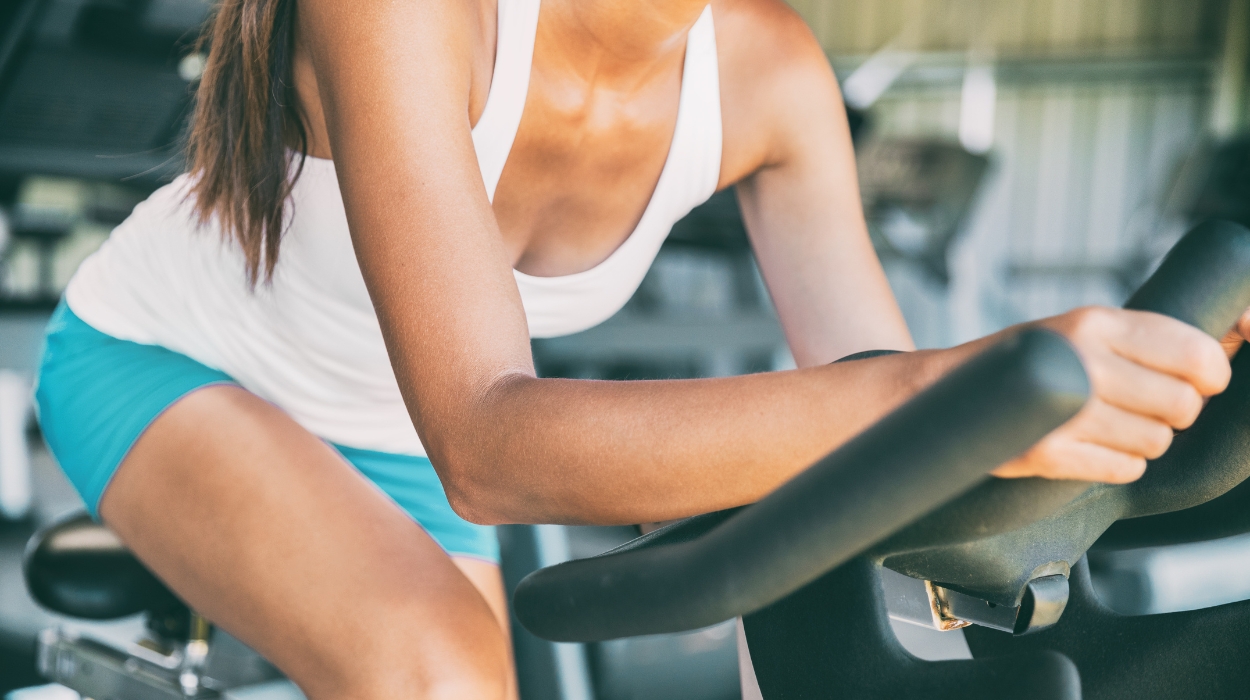 Expert's opinion
Expert's opinion
Expert's opinion
The article is a subjective view on this topic written by writers specializing in medical writing.
It may reflect on a personal journey surrounding struggles with an illness or medical condition, involve product comparisons, diet considerations, or other health-related opinions.
Although the view is entirely that of the writer, it is based on academic experiences and scientific research they have conducted; it is fact-checked by a team of degreed medical experts, and validated by sources attached to the article.
The numbers in parenthesis (1,2,3) will take you to clickable links to related scientific papers.
Do Sit-Ups Burn Belly Fat? The Truth You May Not Know 2024

Belly fat, also known as visceral fat, is one of the most challenging types of fat to lose. It’s also imperative to tone down your tummy, not for vanity reasons, but because excess fat around your abdomen stores deep inside and around your organs. Belly fat increases your risk[1] for numerous health conditions such as
- Heart disease
- Type 2 diabetes
- Cancer
- Gallbladder disease
- Metabolic syndrome
Everywhere you turn, a trick or technique claims to help melt away that stubborn belly fat.
In regards to exercising to slim down, will sit-ups, or crunches, work? Do sit-ups burn belly fat? Is exercise the best way to crush this weight loss goal? The truth may surprise you.
In this article, we’ll discover what exercises can help you shed your belly fat, if crunches are the best option, and what other techniques may help you obtain the flat belly you hope for.
Do Sit-Ups Help With Belly Fat?
Crunches can help with many things. Regularly incorporating these into your routine can improve the strength of your midsection, giving you better flexibility, balance, pelvic floor support, and more.
But can sit-ups burn belly fat and reduce your waistline? Do sit-ups help you lose weight? Contrary to popular belief, no, they will not.
Do Crunches Burn Belly Fat?
Crunches can help with many things. Regularly incorporating these into your routine can improve the strength of your midsection, giving you better flexibility, balance, pelvic floor support, and more.
But can sit-ups burn belly fat and reduce your waistline? Do sit-ups help you lose weight? Contrary to popular belief, no, they will not.
Crunches are a classic exercise for strengthening your core muscle group and performing sit-ups will not reduce belly fat. Simply working this small muscle group will not increase your body’s temperature enough to activate fat-burning potential. Even controlled trials[2] conclude that abdominal exercises are insufficient for reducing body fat but are effective for increasing muscular endurance.
Losing belly fat is more likely to happen when you’re using multiple large muscle groups for high-intensity workouts, creating enough heat to burn calories, paired with the proper nutrient intake.
Sit-ups will help tone, tighten, and grow your:
- Oblique abdominal muscles.
- Rectus abdominis muscles.
- Transverse abdominus muscles.
- Neck muscles.
Targeting just one spot of your body to reduce fat won’t work, but there are some exercises and other ways to lose fat throughout your body, resulting in the loss of belly fat, too.
Best Exercises To Lose Belly Fat
Physical exercise is one of the best ways to increase the body’s heat for thermogenesis and fat burning. There are countless different exercises out there to choose from, so what are the best ones to lose belly fat?
High-Intensity Interval Training

Not all exercises are created equal. If you’re looking to burn calories and fat as fast as possible, intense exercise techniques, such as HIIT, or high-intensity interval training, may provide you with the desired results. HIIT exercises are designed to keep your heart rate high during short bursts of activity followed by an active rest period (30 seconds of work and 20 seconds of rest).
HIIT exercises are short and intense, increasing your heart rate, body temperature, and muscle mass. Studies show that HIIT. can reduce visceral fat[3] compared to moderate-intense exercises.
Types of HIIT exercises to try at home are:
- Lunge jumps
- Burpees
- Alternate running for one minute and walking for three minutes, and repeat.
- Jumping rope
- Cycling with a stationary bike
- Squat jumps
- Mountain Climbers
Strength Training

Resistance, or strength training exercises, train your muscles to become strong. These grow your muscles, and building muscle increases your metabolism. The more muscle you have, the higher your metabolic rate and the more fat you can burn!
This 2022 meta-analysis[4] concludes that resistance training reduces belly fat, the percentage of body fat, and the body fat mass that you have.
Many strength training exercises can be done with just your own body weight, and including weights or resistance bands is a bonus muscle builder!
Aim for 10-15 repetitions, two to three days per week, of any of the following:
- Planks
- Squats
- Push-ups
- Lunges
- Weight-lifting
Cardiovascular Exercises

Also known as cardio exercises, this type of vigorous movement uses large muscle groups to increase blood flow and reduce weight. Research shows that cardiovascular exercise can reduce visceral fat,[5] even without reducing calories.
Examples of cardio exercises are
- Swimming
- Cycling
- Jogging
- Squat jumps
- Tennis
- Rowing
Walking

Photo: Shutterstock
While this is a low-impact exercise, it’s the easiest for most people. This 12-week study[6] finds that walking for 50-70 minutes three times a week can not only reduce abdominal obesity but can lower insulin resistance, too.
How Many Exercises Do I Need?
If you’re looking to really slim down your waist, aim for 30-60 minutes daily of moderate-intensity physical activity. But remember, you will not achieve the same results with moderate-intensity exercise as you will with a HIIT routine. With HIIT you can achieve results in less time than with moderately paced exercises, and a 24-hour rest period is normally indicated to recover from HIIT circuits.
If you’re too busy or new at exercising, you still have to start somewhere. Try out a ten or fifteen-minute routine, and increase the time as you can. Something is better than nothing!
Useful Tips To Burn Belly Fat
Besides exercise, there are other ways to try and burn belly fat. The duo of eating right and exercising can increase your chances of burning belly fat, and some people can adjust their portion sizes, diet regimen, or lifestyle and succeed in losing weight.
Let’s talk about some nutritional tips to burn belly fat and other wellness methods you can try.
Go Low-Carb, High-Fat
A low-carbohydrate diet helps your body to rely on burning fat for fuel instead of sugar. This means lowering the amounts of bread, pasta, sugary foods and drinks, and most high-carbohydrate foods. Eating high-fat foods instead of carbohydrates doesn’t mean loads of fried chicken; it means choosing healthy fats for your diets, such as olive oil and avocado.
While trying this way of eating may not be for everyone, science backs up its proof of reducing weight. A pair of studies[7] had a group of participants who were consuming 43% carbohydrates and 39% fat in their daily diet. This nutrient profile resulted in a more significant loss of intra-abdominal fat tissue and total fat mass than the higher carbohydrate diet used as a control diet.
This was compared to a control group consuming a higher carbohydrate and lower fat profile of 55% carbohydrates and 27% fat. In this study, the lower carbohydrate diet showed decreased fasting glucose and increased insulin sensitivity. The study concluded that the lower carbohydrate diet had beneficial effects on losing body weight, glucose metabolism, fat distribution, and body composition.
Increase Your Fiber Intake
Eating high-fiber foods is one of the best weight loss strategies proven to work. Fiber-rich foods slow digestion and fill your stomach, making you less likely to reach for extra calories.
Studies show that increasing the fiber in your diet can improve metabolism and reduce belly fat,[8] and not enough fiber can increase your chances of belly fat. Examples of good food sources of fiber are:
- Avocados
- Oats
- Popcorn
- Nut butter
- Chia seeds
- Legumes
- Vegetables
- Fresh fruits
Avoid Unhealthy Foods
Just like certain foods can decrease your chances of excessive belly fat, eating certain foods can increase your chances of obtaining stubborn belly fat. Avoid these types of nutrition for the best chances of slimming down your waistline:
- Saturated fat
- Trans fat
- High-carbohydrates
- Refined sugar
- Sodium
- Processed foods
- Alcohol
For example, alcohol consumption studies show[9] it increases visceral fat. Other studies find that those drinking sugar-sweetened beverages[10] had a 10% higher amount of belly fat than non-sugar drinkers. Fructose is also bad for belly fat[11] as it increases insulin resistance in cases where sugar did not.
Adequate Hydration
Staying hydrated will help your body to function correctly and have the energy it needs to burn fat. Dehydration[12] can occur without adequate water intake, resulting in weight gain and obesity.
An eight-week hydration study[13] had its 50 participants increase their water intake by 1.5 liters a day. They split this into 500 milliliters three times a day before their breakfast, lunch, and dinner. Measurements at the end of the study showed they had a reduction in appetite, body fat, body mass index, and body weight.
Because certain health conditions can limit how much water you should be drinking each day, check with your registered dietitian or healthcare provider for liquid intake guidance.
Get Enough Sleep
Sleep[14] quality and quantity can affect your weight. Studies show that not getting enough sleep increases hunger and promotes weight gain. On the other hand, getting adequate sleep can help regulate hormones and increase chances of successful fat burning, even when you’re not awake.
Cold Therapy
Another way you can ramp up your body’s ability to lose weight is cold therapy. Exposure to cold temperatures assists in activating brown fat, which helps your body to produce heat and burn more calories.
A 2022 ten-week study[15] evaluating the effect of strength training in a mildly cold environment concluded that cold therapy might be an effective strategy to increase brown adipose tissue. The more brown fat you have, the more fat you can burn since brown fat contains the mitochondria that white fat lacks. Mitochondria are powerhouses of the cell, responsible for increasing heat production and metabolic rate. Furthermore, some water studies[16] show cold therapy can increase your metabolic rates by 350%.
Ways to do this include:
- Cold plunges.
- Cold showers.
- Ice baths.
- Lowering the thermostat at night.
- Taking a long nature walk when it’s cold.
Supplements
Choosing high-quality fat-burning supplements may help you reach your goals in your belly size. Many of them can help decrease bloating, suppress your appetite, or increase your body’s ability to break down fat and burn calories.
For example, fat-burning pills are made from all-natural ingredients to achieve results safely. There are also fat-burning creams that increase blood circulation to the area you apply to help sweat out any extra water weight. Although sweating out extra water weight is not the same as burning fat, it may help reduce bloating and water weight.
The Bottom Line
While burning belly fat can be challenging; you can find what works for you with some time and experimentation. The weight loss process normally takes some time, especially around the midsection.
Combining a high-fiber diet and regular exercise can be an effective way to reduce your waistline. Optimizing your eating, drinking, sleeping, and de-stressing regimens will help set your body up for success.
When it comes to losing weight in the midsection, losing it in a healthy way may take time and perseverance. While lowering your calorie intake in addition to exercise can increase your chances of weight loss, not eating enough for an extended amount of time can place you into a state of nutrient deficiency and actually work against your weight loss by lowering your metabolism.
Even though you may want it gone as soon as possible, some fast and furious-approaches to losing weight can come at the cost of your health. Be sure to speak with a registered dietitian if you need extra guidance for your weight loss journey.
+ 16 sources
Health Canal avoids using tertiary references. We have strict sourcing guidelines and rely on peer-reviewed studies, academic researches from medical associations and institutions. To ensure the accuracy of articles in Health Canal, you can read more about the editorial process here
- Emery, E.M., Schmid, T.L., Kahn, H.S. and Filozof, P.P. (1993). A Review of the Association between Abdominal Fat Distribution, Health Outcome Measures, and Modifiable Risk Factors. American Journal of Health Promotion, [online] 7(5), pp.342–353. doi:https://doi.org/10.4278/0890-1171-7.5.342.
- Vispute, S.S., Smith, J.D., LeCheminant, J.D. and Hurley, K.S. (2011). The Effect of Abdominal Exercise on Abdominal Fat. Journal of Strength and Conditioning Research, [online] 25(9), pp.2559–2564. doi:10.1519/jsc.0b013e3181fb4a46.
- Coker, R.H., Williams, R.H., Kortebein, P.M., Sullivan, D.H. and Evans, W.J. (2009). Influence of Exercise Intensity on Abdominal Fat and Adiponectin in Elderly Adults. Metabolic Syndrome and Related Disorders, [online] 7(4), pp.363–368. doi:10.1089/met.2008.0060.
- Wewege, M.A., Desai, I., Honey, C., Coorie, B., Jones, M.D., Clifford, B.K., Leake, H.B. and Hagstrom, A.D. (2021). The Effect of Resistance Training in Healthy Adults on Body Fat Percentage, Fat Mass and Visceral Fat: A Systematic Review and Meta-Analysis. Sports Medicine, [online] 52(2), pp.287–300. doi:10.1007/s40279-021-01562-2.
- Vissers, D., Hens, W., Taeymans, J., Baeyens, J.-P., Poortmans, J. and Van Gaal, L. (2013). The Effect of Exercise on Visceral Adipose Tissue in Overweight Adults: A Systematic Review and Meta-Analysis. PLoS ONE, [online] 8(2), p.e56415. doi:10.1371/journal.pone.0056415.
- Hong, H.-R., Jeong, J.-O., Kong, J.-Y., Lee, S.-H., Yang, S.-H., Ha, C.-D. and Kang, H.-S. (2014). Effect of walking exercise on abdominal fat, insulin resistance and serum cytokines in obese women. Journal of Exercise Nutrition and Biochemistry, [online] 18(3), pp.277–285. doi:10.5717/jenb.2014.18.3.277.
- Gower, B.A. and Goss, A.M. (2014). A Lower-Carbohydrate, Higher-Fat Diet Reduces Abdominal and Intermuscular Fat and Increases Insulin Sensitivity in Adults at Risk of Type 2 Diabetes. The Journal of Nutrition, [online] 145(1), pp.177S183S. doi:10.3945/jn.114.195065.
- Davis, J.N., Alexander, K.E., Ventura, E.E., Toledo-Corral, C.M. and Goran, M.I. (2009). Inverse relation between dietary fiber intake and visceral adiposity in overweight Latino youth. The American Journal of Clinical Nutrition, [online] 90(5), pp.1160–1166. doi:10.3945/ajcn.2009.28133.
- Kim, K.H., Oh, S.-W., Kwon, H., Park, J.-H., Choi, H. and Cho, B. (2012). Alcohol Consumption and Its Relation to Visceral and Subcutaneous Adipose Tissues in Healthy Male Koreans. Annals of Nutrition and Metabolism, [online] 60(1), pp.52–61. doi:10.1159/000334710.
- Ma, J., Sloan, M., Fox, C.S., Hoffmann, U., Smith, C.E., Saltzman, E., Rogers, G.T., Jacques, P.F. and McKeown, N.M. (2014). Sugar-Sweetened Beverage Consumption Is Associated with Abdominal Fat Partitioning in Healthy Adults. The Journal of Nutrition, [online] 144(8), pp.1283–1290. doi:10.3945/jn.113.188599.
- Richard, G., Blondin, D.P., Syed, S.A., Rossi, L., Fontes, M.E., Fortin, M., Phoenix, S., Frisch, F., Dubreuil, S., Guérin, B., Turcotte, É.E., Lepage, M., Surette, M.G., Schertzer, J.D., Steinberg, G.R., Morrison, K.M. and Carpentier, A.C. (2022). High-fructose feeding suppresses cold-stimulated brown adipose tissue glucose uptake in young men independently of changes in thermogenesis and the gut microbiome. [online] doi:10.1101/2022.01.11.475847.
- Chang, T., Ravi, N., Plegue, M.A., Sonneville, K.R. and Davis, M.M. (2016). Inadequate Hydration, BMI, and Obesity Among US Adults: NHANES 2009-2012. The Annals of Family Medicine, [online] 14(4), pp.320–324. doi:10.1370/afm.1951.
- Vij, V.A. and Joshi, A. (2014). Effect of excessive water intake on body weight, body mass index, body fat, and appetite of overweight female participants. Journal of Natural Science, Biology and Medicine, [online] 5(2), p.340. doi:10.4103/0976-9668.136180.
- Papatriantafyllou, E., Efthymiou, D., Zoumbaneas, E., Popescu, C.A. and Vassilopoulou, E. (2022). Sleep Deprivation: Effects on Weight Loss and Weight Loss Maintenance. Nutrients, [online] 14(8), p.1549. doi:10.3390/nu14081549.
- Tanaka, R., Fuse-Hamaoka, S., Kuroiwa, M., Kurosawa, Y., Endo, T., Kime, R., Yoneshiro, T. and Hamaoka, T. (2022). The Effects of 10-Week Strength Training in the Winter on Brown-like Adipose Tissue Vascular Density. International Journal of Environmental Research and Public Health, [online] 19(16), p.10375. doi:10.3390/ijerph191610375.
- Mooventhan, A. and Nivethitha, L. (2014). Scientific evidence-based effects of hydrotherapy on various systems of the body. North American Journal of Medical Sciences, [online] 6(5), p.199. doi:10.4103/1947-2714.132935.



